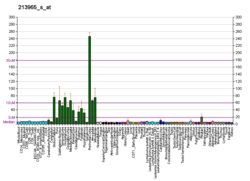| CHD5 |
|---|
 |
| Identifiers |
|---|
| Aliases | CHD5, CHD-5, chromodomain helicase DNA binding protein 5, PMNDS |
|---|
| External IDs | OMIM: 610771; MGI: 3036258; HomoloGene: 56712; GeneCards: CHD5; OMA:CHD5 - orthologs |
|---|
| Gene location (Human) |
|---|
 | | Chr. | Chromosome 1 (human)[1] |
|---|
| | Band | 1p36.31 | Start | 6,101,787 bp[1] |
|---|
| End | 6,180,321 bp[1] |
|---|
|
| Gene location (Mouse) |
|---|
 | | Chr. | Chromosome 4 (mouse)[2] |
|---|
| | Band | 4|4 E2 | Start | 152,423,108 bp[2] |
|---|
| End | 152,474,651 bp[2] |
|---|
|
| RNA expression pattern |
|---|
| Bgee | | Human | Mouse (ortholog) |
|---|
| Top expressed in | - sperm
- right frontal lobe
- cingulate gyrus
- anterior cingulate cortex
- Brodmann area 10
- Brodmann area 9
- pituitary gland
- left testis
- right testis
- primary visual cortex
|
| | Top expressed in | - subiculum
- central gray substance of midbrain
- dorsal tegmental nucleus
- cingulate gyrus
- visual cortex
- habenula
- lateral hypothalamus
- primary visual cortex
- medial vestibular nucleus
- paraventricular nucleus of hypothalamus
|
| | More reference expression data |
|
|---|
| BioGPS | 
 | | More reference expression data |
|
|---|
|
| Gene ontology |
|---|
| Molecular function | - DNA binding
- nucleotide binding
- helicase activity
- metal ion binding
- H3K27me3 modified histone binding
- hydrolase activity
- ATP binding
| | Cellular component | - NuRD complex
- membrane
- heterochromatin
- nucleus
- nucleoplasm
- cytosol
- nuclear speck
| | Biological process | - cell differentiation
- regulation of transcription, DNA-templated
- histone H3-K27 trimethylation
- positive regulation of signal transduction by p53 class mediator
- transcription, DNA-templated
- nervous system development
- spermatogenesis
- histone H4 acetylation
- cerebral cortex neuron differentiation
- negative regulation of cell population proliferation
- chromatin organization
| | Sources:Amigo / QuickGO |
|
| Orthologs |
|---|
| Species | Human | Mouse |
|---|
| Entrez | | |
|---|
| Ensembl | | |
|---|
| UniProt | | |
|---|
| RefSeq (mRNA) | | |
|---|
NM_001081376
NM_029216
NM_001369243 |
|
|---|
| RefSeq (protein) | | |
|---|
NP_001074845
NP_083492
NP_001356172 |
|
|---|
| Location (UCSC) | Chr 1: 6.1 – 6.18 Mb | Chr 4: 152.42 – 152.47 Mb |
|---|
| PubMed search | [3] | [4] |
|---|
|
| Wikidata |
| View/Edit Human | View/Edit Mouse |
|

 1mm2: Solution structure of the 2nd PHD domain from Mi2b
1mm2: Solution structure of the 2nd PHD domain from Mi2b





















